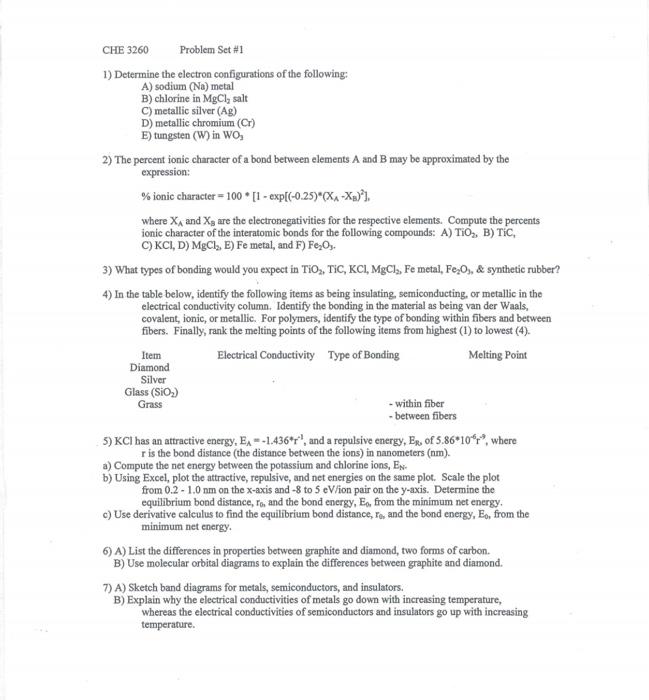CHE 3260 Problem Set #1 1) Determine the electron configurations of the following: A) sodium (Na) metal B) chlorine in MgCl, salt C) metallic silver (Ag) D) metallic chromium (Cr) E) tungsten (W) in WO 2) The percent ionic character of a bond between elements A and B may be approximated by the expression: % ionic character =100 [1 - exp[(-0.25)*(X -XD)*. where X and Xg are the electronegativities for the respective elements. Compute the percents ionic character of the interatomic bonds for the following compounds: A) TIO, B) Tic, C) KCI, D) MgCl, E) Fe metal, and F) Fe2O3, 3) What types of bonding would you expect in TiO, TIC, KCI, MgCl, Fe metal, Fe,0, & synthetic rubber? 4) In the table below, identify the following items as being insulating, semiconducting, or metallic in the electrical conductivity column. Identify the bonding in the material as being van der Waals, covalent, ionic, or metallic. For polymers, identify the type of bonding within fibers and between fibers. Finally, rank the melting points of the following items from highest (1) to lowest (4). Item Electrical Conductivity Type of Bonding Melting Point Diamond Silver Glass (SiO2) Grass - within fiber - between fibers 5) KC has an attractive energy, EA - -1.436*r", and a repulsive energy, Ex of 5.86*10*7", where r is the bond distance (the distance between the ions) in nanometers (nm). a) Compute the net energy between the potassium and chlorine ions, Ex b) Using Excel, plot the attractive, repulsive, and net energies on the same plot. Scale the plot from 0.2 - 1.0 nm on the x-axis and -8 to 5 eV/ion pair on the y-axis. Determine the equilibrium bond distance, to, and the bond energy, Eo, from the minimum net energy c) Use derivative calculus to find the equilibrium bond distance, To, and the bond energy, E., from the minimum net energy 6) A) List the differences in properties between graphite and diamond, two forms of carbon. B) Use molecular orbital dingrams to explain the differences between graphite and diamond. 7) A) Sketch band diagrams for metals, semiconductors, and insulators. B) Explain why the electrical conductivities of metals go down with increasing temperature, whereas the electrical conductivities of semiconductors and insulators go up with increasing temperature







